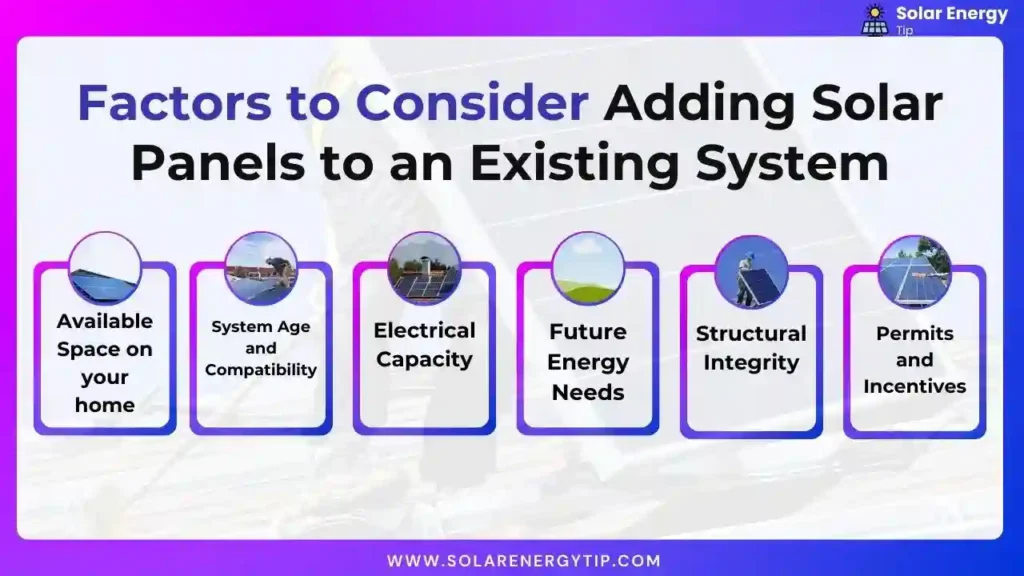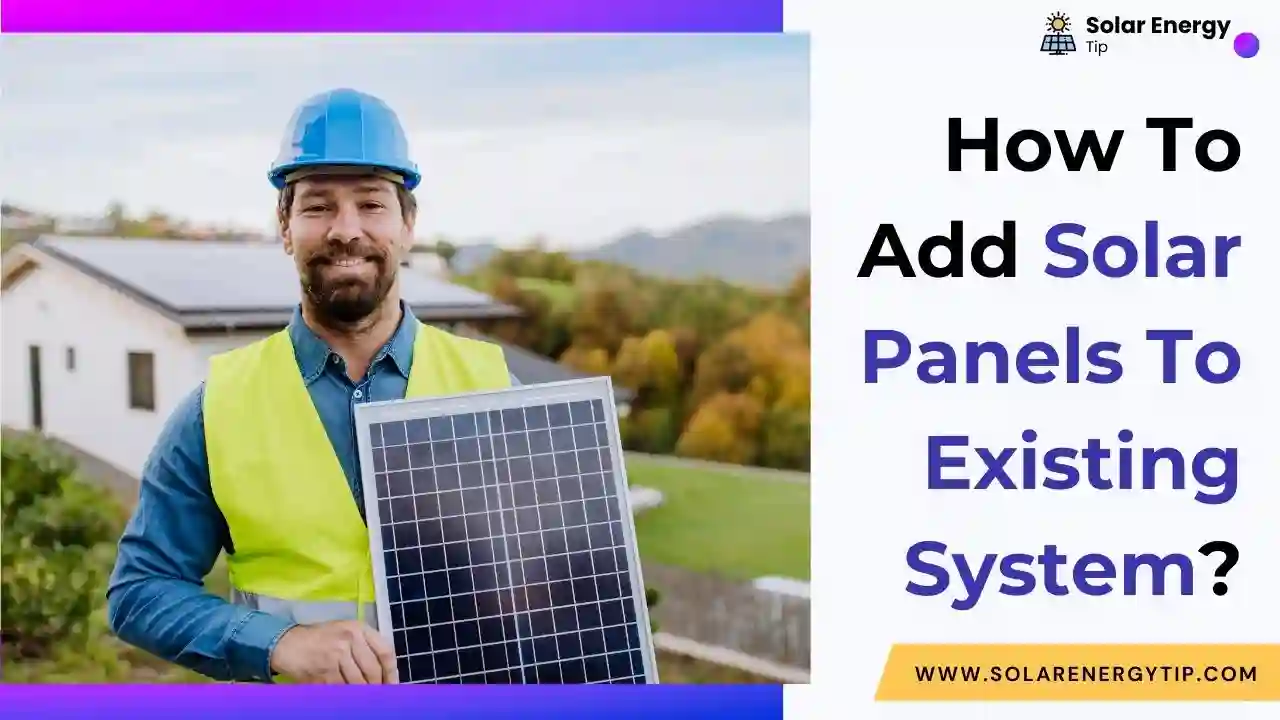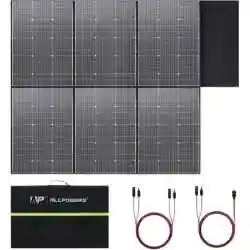Hi, Solar panel users.
If you want to make your home’s solar panels more productive, you need to add more solar panels.
In that case, you may have a question in your mind about how to add solar panels to an existing system.
So, to solve these problems, in this article, I am going to give you information about how to add extra solar panels.
You can’t add more solar panels directly, but some factors need to be taken into account.
First, let’s briefly discuss the factors to consider and then take a closer look at how to add solar panels to your old solar system.
Factors to Consider Adding Solar Panels to an Existing System

When you add solar panels to your existing system, there are several factors that you need to consider.
Here, I am giving you the information.
- Available Space on your home
- System Age and Compatibility
- Electrical Capacity
- Future Energy Needs
- Structural Integrity
- Permits and Incentives
I have discussed all these factors in detail in my other article – can you add more solar panels to an existing system, which you can go through.
How To Add Solar Panels To Existing System? Step-By-Step Guide
If you want to add solar panels to your existing system, you can do it in two ways.
Either you can do it yourself or you can hire a professional installer.
In DIY, you can save costs, but professional installation ensures safety and efficiency. So I will suggest you add solar panels by a professional.
- Step 1: Assess Your Energy Needs
- Step 2: Evaluate Current System Capacity
- Step 3: Check Compatibility
- Step 4: Choose the Right Solar Panel
- Step 5: Determine Placement
- Step 6: Obtain Necessary Permits
- Step 7: Install the Mounting System
- Step 8: Connect the Wiring
- Step 9: Test and Monitor
- Step 10: Enjoy the Benefits
Step 1: Assess Your Energy Needs
The first step is in solar panel expansion; before installing solar panels, you need to assess the energy demand of your home.
Track monthly electricity consumption and its forecast throughout the year, taking into account changes in the environment.
This may require monitoring your primary utility meter and appliance and system consumption.
That will give you an estimate of how much extra power you need and how many panels to add to the existing system.
Step 2: Evaluate the Current System Capacity
Then, do a past technical assessment of your current solar panel.
In the current solar system evaluation, keep the following points in mind.
- The age of the solar system
- Production capacity
- Warranty periods
- Condition monitoring data for critical components like
- Solar panels
- Racking
- Wiring
- Conduit
- Disconnects
- Meters
- Inverters
- Solar Charge Controller
If the system is too old, it is not advisable to add solar panels to it.
Take the next step by considering how much power output each part can handle in the current system and its capacity.
A solar professional can identify any weaknesses or service needs.
Step 3: Check Compatibility
After surveying the current solar system and organizing the need for additional equipment, turn to ensure complete compatibility of the new and old systems.
In AC wiring, the current inverter’s output capacity and voltage must be compatible with any new solar input source.
In DC wiring, also check the type of connector, the maximum input voltage of the string, and the gauge capacity of the wire.
If you’re using a micro-inverter, it’s simple to connect the old and new panels to the AC output.
Step 4: Choose the Right Solar Panel
Choosing new solar panels comes after checking the electrical compatibility and checking the energy consumption.
My recommendation is premium monocrystalline silicon solar panels that are great, with advancements in scale, conversion efficiency, and supply chain features.
ALLPOWERS SP039 600W Monocrystalline Solar Panel
(2 hot wire, 1 neutral)
Plugged US items. This product may need an adapter or converter for international use owing to voltage and outlet variances. Check compatibility before purchase.
Matched panels should have the same wattage rating, size, and frame construction, making mounting integration straightforward.
Check the panel’s warranty for longevity and assurance of power output.
Several panels are suitable for hot and cold wind and snow. If you consult the installers, they will suggest high-quality panels.
Step 5: Determine Placement
After specifying the additional solar panels, make sure to locate the installation on the ground and roof space.
Measure the field position and determine its position based on the approximate angular inclination of the sunlight and the distance to the equipment.
Use algorithms as well as aerial photos to identify and remove buildings, vegetation, and other aging that reduce solar output.
Step 6: Obtain Necessary Permits
Along with adding a maximum number of solar panels, it is necessary to get the required permit and sign off.
Local jurisdictional codes, such as structural entrainment, electrical safety, systems, commissioning net metering protocols, etc., apply when your current meter is modified for solar generation.
Step 7: Install the Mounting System
You must have experience with solar integrated racking to maintain roof integrity or support additional panels while stabilizing ground mounts or consult a professional all-in-one installer.
If you work on the roof throughout the day, safety, along with a strict fall protection protocol, is essential.
Excellent workmanship creates a structural array ready for panel mating and wiring connections.
Step 8: Connect the Wiring
After fitting the mounting system, slowly join the solar panel in place.
Carefully map the DC wiring network and make proper joins to connect the new panels with the existing electric junction boxes, conduits, and disconnecting devices such as batteries, inverters, etc.
Once you complete your connecting wiring step, all is set for commissioning.
Step 9: Test and Monitor
Thus, before getting approval for the newly installed solar panel, do a thorough inspection to catch any defects.
Check its controls like voltage, frequency regulation, ground fort isolation, etc., using multimeters and analyzers.
Step 10: Enjoy the Benefits
Now enjoy the extra power voltage generated by your newly added solar panel.
With this, you can run your extra household equipment and take advantage of it by getting electricity for free.
Common Mistakes and Misconceptions When Expanding Solar System
Please avoid the common mistakes that can compromise the effectiveness of your solar panel installation.
- Overestimating system capacity can cause underperformance and harm.
- Buying solar panels entirely on price, ignoring quality and efficiency.
- Ignoring local laws might lead to legal and safety consequences.
- Neglecting installation safety, endangering yourself and others.
- Poor maintenance can lower system efficiency and lifespan.
Faqs
How do I know if my inverter can handle more panels?
Check your inverter’s maximum DC input rating in kilowatts or amperage and ensure that added solar panel capacity won’t exceed that level.
Can I mix and match different brands of solar panels?
Yes, you can mix and match solar panel brands when expanding an array, as long as the new panel’s electric output specs match properly with the existing system infrastructure and components.
Is it necessary to get a professional for the installation?
Skill and comfort determine if you need a pro to install solar panels. A summary of professionals and DIYs is below:
Installation by yourself:
- Pros: Cost-effective, satisfying.
- Cons: Expertise, unique tools, safety hazards, warranty voiding.
Installation by professionals:
- Pros: Promised safety, peak performance, warranty, piece of mind.
- Cons: Expensive, dependent.
The choice is yours. Solar panel systems use high-voltage electricity. Always emphasize safety and seek an expert if unsure.
Is there a limit to how many solar panels you can have?
No, there is no limit to this, but the number of panels depends on available space, power capacity, and regulations.⚡
How hard is it to add solar panels to an existing system?
It is a hard and complex process of adding solar panels to an existing system without electrical expertise.
Still, it becomes more forward when hiring a professional solar installer to handle all the steps.
Conclusion on How to Add Solar Panels to Existing System
In conclusion, By following the step-by-step guide provided here and avoiding common mistakes, you can confidently add solar panels to your existing system.
One thing to remember is that proper installation and regular maintenance are the keys to getting the most out of your solar investment.
So, pave your way to a sustainable future by making the most of solar power.
Apart from this, if you have any other solar panel-related problems, please comment to me.


